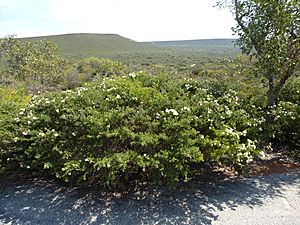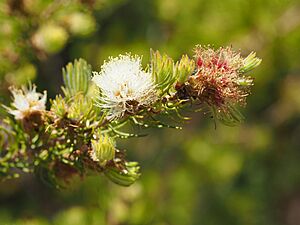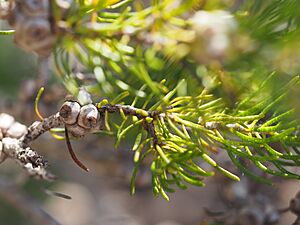Melaleuca urceolaris facts for kids
Quick facts for kids Melaleuca urceolaris |
|
|---|---|
 |
|
| Melaleuca urceoloris growing in the Lesueur National Park | |
| Scientific classification | |
| Genus: |
Melaleuca
|
| Species: |
urceolaris
|
Melaleuca urceolaris is a special kind of plant. It is a low, spreading shrub from the myrtle family, called Myrtaceae. This plant is found only in the south-west part of Western Australia. It's not often grown in gardens, but it's a beautiful plant. People like its soft leaves and white flowers. These flowers change color to pink or red as they get older. Melaleuca urceolaris looks a lot like another plant called Melaleuca scabra. People have often mixed them up!
Contents
What Does Melaleuca Urceolaris Look Like?
Melaleuca urceolaris is a shrub that grows up to about 1.5 m (5 ft) tall. Its branches spread out to 1 m (3 ft) or more. The leaves grow one after another along the stem. They are usually long and thin, about 6.7–20 mm (0.3–0.8 in) long. They are also very narrow, only about 0.6–1 mm (0.02–0.04 in) wide. Small, soft hairs cover the leaves, giving them a grey-green color.
The Flowers and Fruits
The flowers of Melaleuca urceolaris grow in round groups. These groups can be up to 25 mm (1 in) across. Each group has 2 to 12 flowers. You can see these flowers from August to November. When they first appear, they are white, cream, or light yellow. But as they age, they turn pink or red. Inside each flower, there are five groups of stamens. Stamens are the parts that make pollen. Each group has 9 to 15 stamens. The bottom part of the flower is hairy and about 1.5–2.5 millimetres (0.06–0.1 in) long. After the flowers, the plant makes woody fruits. These fruits are like small boxes called capsules. They are about 2.8–4 mm (0.1–0.2 in) long.
How Did Melaleuca Urceolaris Get Its Name?
The plant Melaleuca urceolaris was first officially described in 1867. A scientist named George Bentham wrote about it in a book called Flora Australiensis. The second part of its name, urceolaris, comes from a Latin word. That word is urceus, which means "urn" or "pitcher". This name was chosen because of the shape of the plant's fruit. The fruit looks a bit like a small urn or pitcher!
Where Does Melaleuca Urceolaris Grow?
Melaleuca urceolaris is found in several areas of Western Australia. These areas include the Arrino, Jurien Bay, and Gingin districts. It grows in different types of natural areas. These include dense heathlands, low shrublands, and woodlands. You can find it growing in sandy soil, or sand over a type of rock called laterite. It also grows in sandy clay and gravel.
Is Melaleuca Urceolaris Protected?
The Government of Western Australia's Department of Parks and Wildlife keeps track of plants. They have classified Melaleuca urceolaris as "not threatened". This means it is not currently in danger of disappearing.
How People Use Melaleuca Urceolaris
Growing Melaleuca Urceolaris in Gardens
This plant is known as a "handsome foliage shrub." This means it has very attractive leaves. When it flowers, it looks amazing, especially if it's a good variety. It grows well in poor, sandy soil. It prefers areas that get winter rain. These places can be mild to semi-dry.
Special Oils from the Leaves
The leaves of Melaleuca urceolaris contain a special oil. This oil is mostly made of natural chemicals called monoterpenoids. About 0.6% of the fresh leaves' weight is this oil.
Images for kids
-
Habit in the Lesueur National Park




